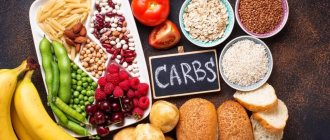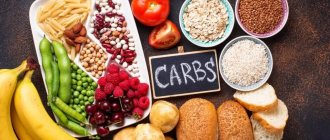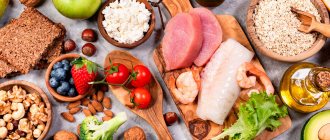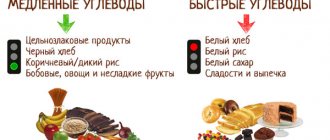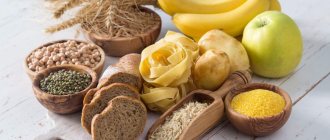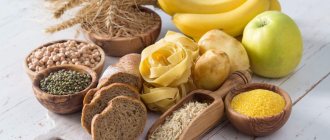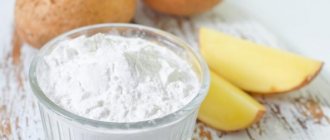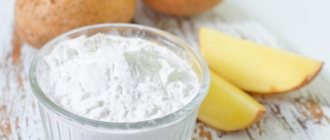Legumes: Pixabay Complex carbohydrates are the substances from which the body draws energy. There are many diets based on regulating intake . I'll tell you about the products that them .
Why are carbohydrates needed?
It should be remembered that all carbohydrates in foods are broken down in the body into glucose, which is a source of energy, stimulates thinking and mental activity, nourishes nerve cells, starts the processes of digestion and respiration, and is spent on physiological needs.
Therefore, it is not recommended to give up carbohydrates under any circumstances. You just need to determine which carbohydrates are healthy and which are harmful.
A deficiency of carbohydrate-containing foods in the diet leads to diseases of the heart and blood vessels, impairs memory, provokes headaches, muscle cramps, reduces concentration and the ability to perform mental stress. Therefore, it is important to know the optimal carbohydrate intake.
Products containing polysaccharides
There are foods that contain only simple sugars or complex ones. How to prepare them so that they bring maximum benefit to the body? The following table shows which foods contain complex carbohydrates and how to properly prepare them for proper nutrition.
| Products | Group Description |
| Vegetables and greens | Most of them are found in vegetables and herbs. The richest of them: tomatoes, bell peppers, zucchini, leeks, celery, cabbage, spinach, lettuce. These vegetables contain virtually no calories, especially if eaten fresh. It’s good to steam vegetables or make smoothies out of them. They need to be cooked until half cooked, and some of the beneficial elements go into the decoction. High temperatures and prolonged cooking reduce the benefits of vegetables. |
| Berries and fruits | This group of products contains both difficult-to-digest carbohydrates and simple ones. The GI indicator is important here. They must be eaten raw. The most ideal are: kiwi, apples, figs, cherries, peaches and pomegranates. Some of them are: bananas, watermelon, mangoes and pineapples, which are very healthy, but they have a high GI. Canned food made from these products in its own juice does not lose its good quality. Of the dried fruits, dried apricots are considered the healthiest. Freshly squeezed juice without added sugar is healthy. |
| Dairy | This group does not contain complex carbohydrates, they only contain disaccharides. In addition to sugars, milk contains a lot of phosphorus, calcium, and vitamins. You can eat these products every day, but don’t overdo it. |
| Porridge | All whole grain porridges bring great benefits to the body. Such grains include oatmeal, bulgur, buckwheat, wheat and brown rice. It is not recommended to eat semolina and muesli. The best way to prepare cereals is to steam them with boiling water or kefir. Buckwheat or oats filled with kefir cleanse the body of harmful elements. |
| Cereals and legumes | This group of products contains a lot of fiber and is very useful for weight loss. From this group it is recommended to eat: bread and pasta made from coarse flour or whole grains, barley or oat flakes. Fiber stimulates intestinal motility, removes toxins and suppresses the feeling of hunger. And the group of legumes regulates carbohydrate levels and saturates the body with proteins. The best products: peas, chickpeas, lentils, boiled beans. |
| Beverages | Freshly squeezed juices from fruits, berries and vegetables always contain slow carbohydrates. There are a lot of them in tomato juice. In other drinks made from plant materials, there are not too many polysaccharides, but when you are on a diet for weight loss, it is right to drink a glass of juice for a snack rather than snack on a bun. |
When choosing foods, you should consider their calorie content. The more high-calorie ones are best eaten before lunch. With a sedentary lifestyle, it is necessary to limit foods high in polysaccharides in the diet. Knowing which foods contain complex carbohydrates and certain types of polysaccharides, you can safely eat them and not be afraid of gaining weight. It is important to eat a balanced diet, then metabolic processes will not be disrupted and the risk of gaining excess weight will not increase.
The benefits and harms of carbohydrates
The structural unit of all carbohydrates is saccharides. Healthy carbohydrates differ from harmful ones in their chemical composition and number of structural units. In this regard, they distinguish:
- Monosaccharides - consist of one structural unit (fructose or glucose) and are absorbed in the body instantly.
- Disaccharides are a combination of two structural units and, like monosaccharides, are classified as simple carbohydrates.
- Polysaccharides contain three or more units, and due to their complex molecular formula, they are broken down slowly in the body, which is why they are called slow carbohydrates.
Simple carbohydrates
Simple carbohydrates are harmful to the body. They instantly appear in the blood and increase sugar levels. These include glucose, fructose and their various compounds. Products containing quickly digestible carbohydrates are:
- Sugar is a combination of glucose and fructose (sucrose).
- Fruits, sweets, milk (it contains lactose - milk sugar), some vegetables.
Among vegetables, potatoes are considered a conditionally harmful product, since the breakdown of starch-containing substances produces maltose - it contains two glucose molecules, which are fast carbohydrates.
Complex carbohydrates
Complex carbohydrates include: fiber, dietary fiber, glycogen, pure starch. Their advantage is their slow absorption. The body receives the energy it needs and manages to spend it, so fat is not deposited.
Sources of slow digestion carbohydrates are:
- Cereals, durum pasta.
- Bread products made from wholemeal flour.
- Legumes (except soybeans).
- Vegetables (cabbage, greens, pumpkin, cucumbers, tomatoes).
- Unsweetened varieties of fruits, berries.
Healthy carbohydrates are absorbed slowly and do not cause spikes in blood sugar. The absorption of a well-thought-out carbohydrate breakfast takes 3.5-4 hours - the entire period the person feels full.
What does carbohydrate deficiency lead to?
You won't be able to stock up on complex carbohydrates for future use. Physical activity and intellectual work contribute to the absorption of polysaccharides. To maintain normal functions, the body needs a sufficient amount of carbohydrate foods.
Complex carbohydrates should make up the bulk of your daily diet. Their optimal daily volume for a healthy person should be from 55 to 75% of the total amount of food. No more than 10% of this amount should be simple (fast) carbohydrates. To maintain normal weight, the daily diet of an adult requires the presence of 20-25 g of fiber.
In case of a lack of carbohydrates, the body launches compensation mechanisms. To obtain the necessary energy, one begins to consume one's own proteins and fats, rather than those coming from outside. Protein breakdown provokes the destruction of muscle fibers and a slowdown in metabolism. Consumption of fat to provide energy to the body leads to the formation of ketone bodies and subsequent intoxication. A person feels a deficiency of carbohydrates physically, as constant fatigue, drowsiness, while absent-mindedness and impaired concentration appear.
Complex carbohydrates provide healthy energy. A healthy diet should include foods rich in plant fiber (cereals, vegetables, whole grain bread, fruits).
Absorption of healthy carbohydrates
Due to the fact that complex carbohydrates are absorbed gradually, they participate in a weight loss program and promote weight loss. To assess the usefulness of products, the glycemic index (GI) is used, which characterizes the rate of absorption of substances by the body. The amount of carbohydrates consumed per day is also important.
Potatoes are included in the list of complex carbohydrates, however, their glycemic index is high and they are quickly absorbed. In addition, potatoes contain large amounts of sugar. This must be taken into account when drawing up a carbohydrate menu for a diet.
Why consider the glycemic index of foods
For an adult, a normal blood glucose level is considered to be between 4.1 and 5.9 mmol/l (depending on the laboratory, the upper and lower limits may differ slightly from those indicated). An indicator such as the glycemic index of foods affects blood glucose levels. It is carbohydrates that lower or increase “sugar” in the body. It is necessary to take into account the GI of foods if you want to lose weight or have health problems such as insulin resistance and diabetes. The higher the glycemic index, the faster carbohydrates are digested. And, accordingly, the level of glucose in the blood will increase. For this reason, preference should be given to slow carbohydrates, and fast carbohydrates should be limited or removed from the diet. From the table below it is clear that there is no relationship between the energy value of foods and GI. Thus, food may not be sweet at all, but have a high glycemic index.
| Product (100 g) | Glycemic index | Calorie content, kcal |
| Slow carbohydrates | ||
| Brown rice | 45 | 111 |
| Chickpeas | 30 | 364 |
| Fast carbohydrates | ||
| Semolina | 80 | 369 |
| White rice | 70 | 130 |
Healthy carbohydrates for weight loss
Foods containing carbohydrates that are healthy and promote weight loss are:
- Bran, oats, peas, lentils, beans.
- Apples, citrus fruits, berries.
- Barley, buckwheat, brown rice.
- White cabbage and all other types of cabbage.
Unlike fast carbohydrates, the substances in these products contain dietary and plant fibers, which improve intestinal motility, normalize metabolic processes, and create beneficial microflora in the intestines.
Top 10 foods with complex carbohydrates
The advantage of complex carbohydrates is long-term saturation after consumption. Already in the first minute, uniform breakdown of the nutrient begins, and the body receives energy. The digestion process continues for about 2-3 hours. If such food contains a lot of dietary fiber, then the total time may increase. At the same time, vitamins, minerals, and plant proteins also enter the gastrointestinal tract.
If you constantly crave snacks or feel hungry, your diet may not have enough slow-acting carbohydrates. Let's figure out what foods with slow carbohydrates are possible on a healthy diet.
Buckwheat
What is the benefit of the product: Supports the body's energy charge. Fatigue goes away and a feeling of fullness appears for a long time. The metabolic process accelerates, the functioning of the immune system is enhanced, and the lipid profile improves. Buckwheat is involved in the growth of strength and muscle volume. Leads among products with complex carbohydrates. A lot of protein, magnesium, zinc, iron and manganese, B vitamins. For fiber: 100 grams of cereal replenishes the daily requirement by 63%.
KBJU per 100 g: Proteins – 12.6 g; fats – 3.3 g; carbohydrates – 62.1 g. Calories – 313 kcal.
Brown (brown) rice
What are the benefits of the product: Reducing cravings for overeating and weakening appetite, replenishing energy reserves, getting rid of fatigue. The work of the gastrointestinal tract, central nervous system, heart and blood vessels, and liver is supported. The level of glucose and cholesterol in the blood is normalized, free radicals are neutralized. Rice grains contain a lot of vitamins B1, B5, B6 and B9, PP, manganese, phosphorus, magnesium and selenium.
KBJU per 100 g: Proteins – 6-7 g; fats – 4-4.5 g; carbohydrates – 65 g. Calories – 331 kcal.
Barley grits
What are the benefits of the product: Improving the functionality of the gastrointestinal tract, supporting the central nervous system and immune system, improving sleep, eliminating insomnia. They provide grains with energy, resulting in a long-lasting feeling of satiety. The blood vessels and muscle fibers of the heart are strengthened, cholesterol is regulated, and the production of hormones is normalized. It has an anti-inflammatory, diuretic, and restorative effect. The body needs proteins, vitamins B, E, PP and potassium, phosphorus, magnesium, selenium.
KBJU per 100 g: Proteins – 10.4 g; fats – 1.3 g; carbohydrates – 66.3 g. Calories – 324 kcal.
Oat groats
What are the benefits of the product: Providing long-term satiety, restoring strength and energy after physical or mental stress, relieving tension. Participation in the synthesis of serotonin, relieving the central nervous system of the influence of stress factors, reducing anxiety. The functioning of the intestines and central nervous system is normalized, bones are strengthened, and the heart muscle is supported. Vitamins B, PP, phosphorus, calcium and potassium go from the composition into the body.
KBJU per 100 g: Proteins – 12 g; fats – 7.2 g; carbohydrates – 70 g. Calories – 366 kcal.
Couscous
What are the benefits of the product: Stimulation of metabolism, improvement of gastrointestinal functions and stabilization of water-salt metabolism. The level of bad cholesterol in blood vessels decreases, hemoglobin increases. The immune system is strengthened, the gastrointestinal tract is cleared of toxins and food debris, and the brain functions faster. At the same time, the body is fueled with energy, sleep improves, and bad mood dissipates. Couscous contains B vitamins, selenium, iron and manganese.
KBJU per 100 g: Proteins – 12-13 g; fats – 1 g; carbohydrates – 72-73 g. Calories – 376 kcal.
Quinoa (cereal)
What are the benefits of the product: Regulation of lipid metabolism, reduction of adipose tissue deposits, support of intestinal functions. Brain function accelerates, teeth become stronger, and hemoglobin levels rise. One of the best cereals for weight loss and weight loss. Quinoa is also indicated for those who suffer from diabetes, heart disease and hypertension. Contains a lot of iron, silicon, potassium, calcium, magnesium, phosphorus and iodine, vitamins A, C, E and B.
KBJU per 100 g: Proteins – 14 g; fats – 6 g; carbohydrates – 57 g. Calories – 368 kcal.
Pearl barley
What is the benefit of the product: Supports the health of the musculoskeletal system with joints, cleanses the intestinal walls and removes toxins. The proportion of bad cholesterol and sugar in the blood decreases, and hemoglobin levels increase. Nails and hair grow faster, skin is renewed. The body is saturated with energy. It contains lysine, hordecine, iron, selenium and zinc, vitamins B, D, PP and E, A. This type of cereal is useful for the central nervous system, metabolism, immunity, heart, blood vessels.
KBJU per 100 g: Proteins – 9-10 g; fats – 1.1 g; carbohydrates – 73-74 g. Calories – 324 kcal.
Chickpeas
What is the benefit of the product: Gentle cleansing of the intestines, slowing down the transition of sugar from food into the blood, removing harmful substances. Satiety, strength and energy appear, and the craving for overeating decreases. Chickpeas are good for the heart muscle; the body obtains essential fatty acids from beans. It contains a lot of iodine, zinc, calcium and potassium, iron, vitamins A, E, K, C and group B, protein.
KBJU per 100 g: Proteins – 19 g; fats – 6 g; carbohydrates – 61 g. Calories – 360-365 kcal.
Beans
What are the benefits of the product: Long-term satiety, normalization of lipid composition, as well as help in the fight against extra pounds, stabilization of blood sugar and cholesterol. The digestive process is stimulated, toxins and pollutants are eliminated. Muscle tissue is saturated with amino acids: from lysine with tryptophan to methionine, arginine. One of the most important products with complex carbohydrates contains potassium, calcium, iodine, vitamins B, K and C.
KBJU per 100 g: Proteins – 21 g; fats – 1-2 g; carbohydrates – 50-63 g. Calorie content – 290-325 kcal.
Norm of carbohydrates per day
To create a healthy menu, it is important to adhere not only to the correct list of products, but also to take into account the amount of food consumed. It is necessary to develop a weight loss program taking into account the carbohydrate intake.
If you do not take this indicator into account and consume slow carbohydrates in excessive quantities, your body weight will inevitably increase. Strict consumption monitoring is required.
Effective in matters of weight normalization is interaction with a nutritionist-endocrinologist, who, based on the patient’s current state of health, develops a personal scheme and table of carbohydrate consumption in foods.
In Zelenograd, such care is provided at the Axis Medical Center. Consultations with a nutritionist will help you determine the sources of carbohydrates and their quantity.
Table of foods containing polysaccharides
In order to accurately know and have a good understanding of foods with slow carbohydrates and GI indicators, the following table has been developed:
| Glycemic index | Grocery list |
| 10 | Avocado |
| 15 | Agave syrup, broccoli and Brussels sprouts, some types of nuts, zucchini, white cabbage, onions, beets, cucumbers, bran, greens, lettuce, bell peppers, black currants, peas, champignons |
| 20 | Eggplant, lemon, soy sauce, dark chocolate |
| 25 | Cherries, blackberries, strawberries, gooseberries, raspberries, red currants, pumpkin seeds, blueberries, lentils |
| 30 | Apricot, grapefruit, pear, tangerines, sugar-free marmalade, milk, carrots, tomatoes, raw beets, green beans |
| 35 | Orange, durum wheat pasta, peaches and nectarines, pomegranate, figs, yogurt, poppy seeds, dried apricots, sunflower seeds, wild rice, celery, plums, tomato juice, beans, apples |
The table does not show all ingredients with a high glycemic index content. There are some fruits and vegetables about which there is a lot of controversy. These are persimmons, strawberries and other berries, fruits and vegetables. Before use, it is still important to find out the indicator so as not to provoke an increase in blood sugar levels. For people with diabetes, this negatively affects their overall well-being and vascular condition. For those who simply want to maintain a slim figure, the presence of polysaccharides is contraindicated - an increase in sugar levels also provokes the formation of fat cells.
Video
Why are fast carbohydrates harmful?
Glucose is the main source of energy. Its blood level rises as it is absorbed by the body. In response, the pancreas produces insulin.
If a lot of glucose enters the body, its level quickly increases, then more insulin is produced, even with a “reserve”, especially in people who are already overweight. The necessary glucose enters the cells under the influence of insulin, and the “excess” under the influence of the same hormone – insulin – turns into fat.
But do you remember that insulin was produced “in excess”? Under its continued effect, your glucose level “falls” and you feel hungry and need to eat something else sweet - cookies or chocolate. It turns out to be a vicious circle.
This is how excess weight is gained, and with it fluid retention, stress on the liver, increased cholesterol, narrowing of blood vessels and plaques in them, hypertension and heart disease, diabetes mellitus... And it is extremely difficult to lose weight due to excess insulin, and carbohydrates themselves block the secretion of “ satiety hormone,” and the lover of sweets eats even when he is not hungry. Plus, simple carbohydrates cause addiction, akin to drugs.
